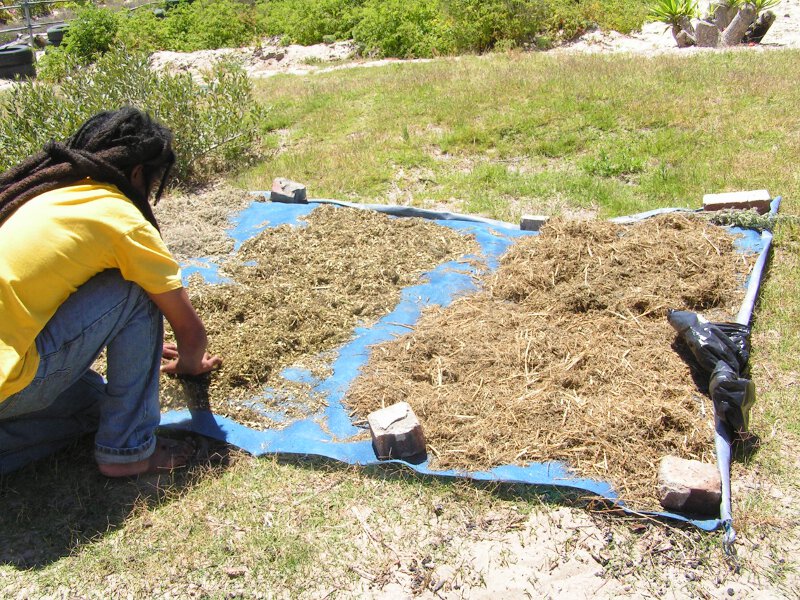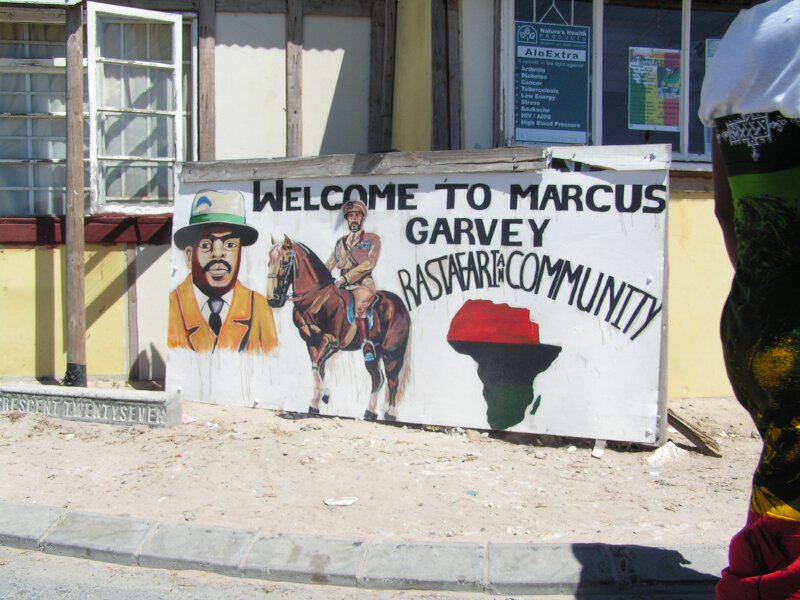-

Full image from the book's cover, a digital collage created by Melissa Robertson (Copyright Melissa Robertson)
-

1.1 Artemisia afra Jaqu. Ex. Willd (Copyright Julie Laplante)
-

Indigenous Knowledge Systems (IKS) meeting, November 2007 (Copyright Julie Laplante)
-

TICIPS PROJECT A.afra powder and powdered animal feed (Copyright Julie Laplante)
-

Dried leaves of A.afra (Copyright Julie Laplante)
-

TICIPS PROJECT A.afra powder (Copyright Julie Laplante)
-

Liquifying A.afra with boiling water to be mixed with the animal feed (Copyright Julie Laplante)
-

Grinding A.afra animal feed (Copyright Julie Laplante)
-

Visit of Delft Laboratories’ medicinal plant garden with a group of isangomas and inyangas, November 2007 (Copyright Julie Laplante)
-

A.afra on display in Delft Laboratories’ medicinal plant garden (inscription on panel reads: Lenga, Umhloyane, Artemisia Afrika), November 2007 (Copyright Julie Laplante)
-

Delft laboratories guided tour with a group of of isangomas and inyangas, December 2007 (Copyright Julie Laplante)
-

Delft laboratories guided tour with a group of of isangomas and inyangas, December 2007 (Copyright Julie Laplante)
-

A.afra bush under the close line in a Rasta family’s backyard, Delft Township, Cape Town (Copyright Julie Laplante)
-

Rastafarian community garden project showing A.afra growing and drying in the sun in Muizenberg Township (Copyright Julie Laplante)
-

Kirstenbosch National Botanical Garden map for the Useful Plant Garden (Copyright Julie Laplante)
-

Rastafarian inyanga medicinal plant stall in Cape Town market (Copyright Julie Laplante)
-

Xhosa chemist shop in Khayelitsa Township, Cape Town South Africa (Copyright Julie Laplante)
-

Xhosa chemist shop in Khayelitsa Township, Cape Town South Africa (Copyright Julie Laplante)
-

Gathering roots during a plant collection journey, outskirts of Cape Town (Copyright Julie Laplante)
-

Gathering roots during a plant collection journey, outskirts of Cape Town (Copyright Julie Laplante)
-

Meditative discussions around relations with the environment in Atlantis Dunes, outskirts of Cape Town (Copyright Julie Laplante)
-

SunSplash Rastafarian festival filled with wild herbs sold by rastafarian 'renouncers' of all material belongings (Copyright Julie Laplante)
-

A.afra fields, Grassroots Inc., outskirts of Cape Town (Copyright Julie Laplante)
-

Isangoma, Khayelitsa Township, Cape Town (Copyright Julie Laplante)
-

Delft Township, Cape Town South Africa (Copyright Julie Laplante)
-

'The Everlivings'. Photography by Melissa Robertson (Copyright Melissa Robertson)
-

Marcus Garvey Rastafarian community welcoming banner, Philippi Township, Cape Town South Africa (Copyright Julie Laplante)

Series
Volume 15
Epistemologies of Healing
See Related
Anthropology JournalsEmail Newsletters
Sign up for our email newsletters to get customized updates on new Berghahn publications.
Healing Roots
Anthropology in Life and Medicine
Julie Laplante
302 pages, 25 illus., bibliog., index
ISBN 978-1-78238-554-7 $135.00/£104.00 / Hb / Published (February 2015)
ISBN 978-1-78920-059-1 $34.95/£27.95 / Pb / Published (July 2018)
eISBN 978-1-78238-555-4 eBook
Reviews
“Overall, Laplante’s Healing Roots, focusing on the tensions between the biomedical and traditional healing–based ways of making a medicine is an informative and important contribution to the literature [of] intrinsic value in the classroom, primarily for graduate-level students with specific interests in South Africa and the crossroads of ethnopharmacology and biomedicine.” • Medical Anthropology Quarterly
“Healing Roots should be compulsory reading for students of pharmacology in Africa. That statement summarizes the wealth of information and in-depth analysis contained in a book that set out to, and succeeded in articulating the dissonance that exists in attempts to validate indigenous medicine using completely alien and super-imposed standards.” • African Studies Quarterly
“This book represents an interesting addition to the emerging series of articles and books dedicated to the study of the interactions between Western and African systems of knowledge…[It] is very provocative and will no doubt provoke many intellectual debates.” • Gilles Bibeau, Université de Montréal
Description
Umhlonyane, also known as Artemisia afra, is one of the oldest and best-documented indigenous medicines in South Africa. This bush, which grows wild throughout the sub-Saharan region, smells and tastes like “medicine,” thus easily making its way into people’s lives and becoming the choice of everyday healing for Xhosa healer-diviners and Rastafarian herbalists. This “natural” remedy has recently sparked curiosity as scientists search for new molecules against a tuberculosis pandemic while hoping to recognize indigenous medicine. Laplante follows umhlonyane on its trails and trials of becoming a biopharmaceutical — from the “open air” to controlled environments — learning from the plant and from the people who use it with hopes in healing.
Julie Laplante is Associate Professor of Anthropology in the School of Sociological and Anthropological Studies at the University of Ottawa. Senior research fellow at the Max Planck Institute für etnologische forschung (2006-2010), she has published in numerous journals and is the author of Pouvoir Guérir. Médecines autochtones et humanitaires (Power/Ability to Heal. Indigenous and humanitarian medicine).

